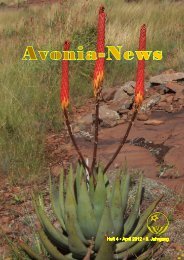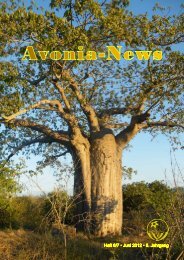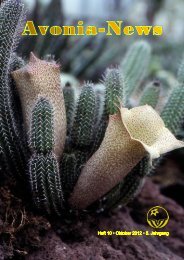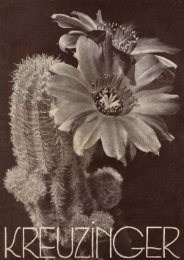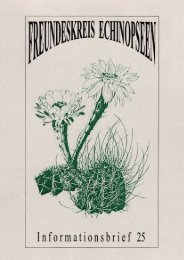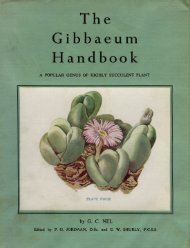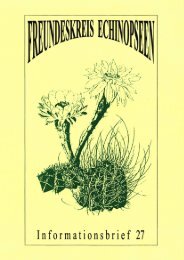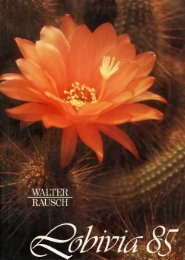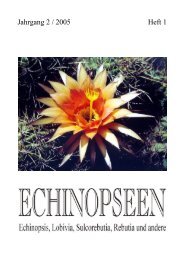VOLUME 14 :: January—October, 1952 Illustrations shown in ...
VOLUME 14 :: January—October, 1952 Illustrations shown in ...
VOLUME 14 :: January—October, 1952 Illustrations shown in ...
You also want an ePaper? Increase the reach of your titles
YUMPU automatically turns print PDFs into web optimized ePapers that Google loves.
THE CACTUS AND SUCCULENT January, <strong>1952</strong><br />
UNCOMMON SUCCULENTS<br />
By G. G. GREEN<br />
Dur<strong>in</strong>g a recent visit to Mr. Shurly's home, I was pleasantly surprised to notice that his well grown plant of<br />
Bowiea volubilis was <strong>in</strong> full bloom. The m<strong>in</strong>ature greenish-white flowers, so similar to those of the Asparagus<br />
fern, were fully opened <strong>in</strong> their hundreds at the top of the branch<strong>in</strong>g stem, and though not to be called beautiful,<br />
were nevertheless, very pretty.<br />
The surprise was really <strong>in</strong> the forwardness of the growth, for the Editor is no believer <strong>in</strong> coddl<strong>in</strong>g, but prefers<br />
to give his plants as much ventilation as possible, which results <strong>in</strong> much stronger specimens. I told him that m<strong>in</strong>e<br />
had not yet flowered, and <strong>in</strong>deed, it was two weeks later that the first t<strong>in</strong>y blooms opened, show<strong>in</strong>g that the<br />
difference <strong>in</strong> latitude between the north and the south has a great deal to do with the times of growth and bloom<strong>in</strong>g<br />
of the majority of plants.<br />
This difference accounts, no doubt, for the fact that many amateurs who follow the usual rout<strong>in</strong>e of water<strong>in</strong>g<br />
and rest, do not, <strong>in</strong> some seasons, get the amount of growth and bloom that is to be found <strong>in</strong> the south. In the<br />
north of England the summer beg<strong>in</strong>s much later and I th<strong>in</strong>k the water<strong>in</strong>g and grow<strong>in</strong>g periods should be extended<br />
slightly <strong>in</strong> the autumn to enable the plants to have as much time as possible <strong>in</strong> which to develop and ripen.<br />
So long as there is no fear of heavy frost, I see no reason why growth should not be encouraged right up to the<br />
end of September, and the slacken<strong>in</strong>g off <strong>in</strong> water<strong>in</strong>g, etc. dur<strong>in</strong>g the latter part of October. This extra time, for<br />
us up here at least, will be welcomed by the Succulents as a whole, and they will then have a more normal season<br />
of growth. In their native homes, the plants are used to a much longer period than they can possibly get <strong>in</strong> these<br />
islands.<br />
I have many times po<strong>in</strong>ted out to disappo<strong>in</strong>ted collectors that their plants have suffered from too short a season<br />
of growth, caused by the premature dry<strong>in</strong>g-off when they are just com<strong>in</strong>g <strong>in</strong>to the full flush of growth. This is<br />
seen <strong>in</strong> many cases, by the failure to develop of late flower buds and the shr<strong>in</strong>k<strong>in</strong>g and brown<strong>in</strong>g of the tissues at<br />
the grow<strong>in</strong>g po<strong>in</strong>ts, or the dropp<strong>in</strong>g off of leaves by the succulents. More satisfaction and success will be found<br />
if this grow<strong>in</strong>g period is not curtailed so soon.<br />
Bowiea volubilis, from South Africa, has not much to recommend it as a collector's piece, but when properly<br />
grown it can provide an attractive background subject, as the fern-like foliage is very useful for space fill<strong>in</strong>g or<br />
tra<strong>in</strong><strong>in</strong>g up the lean-to wall. Actually, the foliage is part of the <strong>in</strong>florescence and there are no leaves, as such, on<br />
the plant. What do form drop off very quickly.<br />
The stems, generally two on mature plants, arise from an onion shaped bulb of a sh<strong>in</strong><strong>in</strong>g green colour, and similar<br />
to a hyac<strong>in</strong>th dur<strong>in</strong>g the rest<strong>in</strong>g period. It is customary to plant the bulb <strong>in</strong> rich sandy soil so that only one third<br />
is below ground level, <strong>in</strong> order to prevent rott<strong>in</strong>g dur<strong>in</strong>g the rest<strong>in</strong>g period when no water should be given.<br />
Dur<strong>in</strong>g late spr<strong>in</strong>g and summer, liberal water<strong>in</strong>g can be given until the stems beg<strong>in</strong> to wither or dry up and<br />
no more until the follow<strong>in</strong>g spr<strong>in</strong>g or until new shoots appear.<br />
The plants are easily propagated from seed sown <strong>in</strong> the usual way, or from pieces of bulb taken from the outer<br />
layers. These should be carefully removed dur<strong>in</strong>g the rest<strong>in</strong>g period, <strong>in</strong> portions similar to those of the garden<br />
lilies such as lancifolium or madonna, and fixed upright <strong>in</strong> a mixture of sand and peat. New bulblets will develop<br />
at the base the follow<strong>in</strong>g spr<strong>in</strong>g and will soon make good plants.<br />
Another unusual genus, and one that for some unknown reason is rather rare <strong>in</strong> collections, is the Pelargonium,<br />
of the family Ceraniaceae. These succulent members of this great geranium family are most <strong>in</strong>terest<strong>in</strong>g and unusual,<br />
and fairly easy to grow. Some species develop beautifully coloured flowers and foliage, and are <strong>in</strong> bloom for<br />
several weeks dur<strong>in</strong>g early summer, mak<strong>in</strong>g a most attractive display.<br />
The very succulent stems gradually harden with age either <strong>in</strong>to short, sp<strong>in</strong>y and irregular growth, or are semi<br />
climb<strong>in</strong>g with long slender branches. The taller species branch very freely and can be tra<strong>in</strong>ed <strong>in</strong>to compact bushes,<br />
or supported on canes <strong>in</strong>to very handsome specimens.<br />
The leaves are smaller than those of the ord<strong>in</strong>ary greenhouse Pelargonium and are prettily marked <strong>in</strong> green<br />
and reds, with m<strong>in</strong>ute silky white hairs and curl<strong>in</strong>g edges. The flowers of these species are brightly coloured and<br />
ve<strong>in</strong>ed <strong>in</strong> p<strong>in</strong>ks and purples look<strong>in</strong>g like small orchids, and are very freely produced dur<strong>in</strong>g the early summer.<br />
The smaller, or low grow<strong>in</strong>g species, generally have thick, swollen, tuber-like stems with many notches and<br />
sp<strong>in</strong>es, the rema<strong>in</strong>s of previous growth. The branches are th<strong>in</strong> at first, be<strong>in</strong>g thickened at the nodes and bear<strong>in</strong>g<br />
the leaves on very long stalks. They like a well dra<strong>in</strong>ed gritty soil that must be porous, for the stems soon rot if<br />
they have to endure prolonged dampness. A sunny position will prevent any leggy growth and will ripen the<br />
stems ready for the rest<strong>in</strong>g period dur<strong>in</strong>g our w<strong>in</strong>ter.




